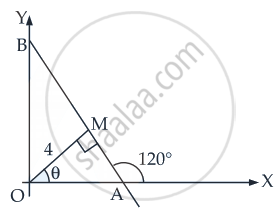Advertisements
Advertisements
Question
Find the equation of a straight line on which length of perpendicular from the origin is four units and the line makes an angle of 120° with the positive direction of x-axis.
Solution
Given that: OM = 4 units
∠BAX = 120°
∴ ∠BAO = 180° – 120° or ∠MAO = 60°
∠MOA + MAO = 90° ......[∵ OM ⊥ AB]
θ + 60° = 90°
∴ θ = 30°
So, equation of AB in its normal form
x cos θ + y sin θ = p
⇒ x cos 30° + y sin 30° = 4
⇒ `x xx sqrt(3)/4 + y xx 1/2` = 4
⇒ `sqrt(3)x + y` = 8
Hence, the required equation is `sqrt(3)x + y` = 8
APPEARS IN
RELATED QUESTIONS
Find the distance between P (x1, y1) and Q (x2, y2) when :
- PQ is parallel to the y-axis,
- PQ is parallel to the x-axis
Find the slope of the line, which makes an angle of 30° with the positive direction of y-axis measured anticlockwise.
Without using distance formula, show that points (–2, –1), (4, 0), (3, 3) and (–3, 2) are vertices of a parallelogram.
If three point (h, 0), (a, b) and (0, k) lie on a line, show that `q/h + b/k = 1`
Consider the given population and year graph. Find the slope of the line AB and using it, find what will be the population in the year 2010?

Find the slope of the lines which make the following angle with the positive direction of x-axis: \[\frac{\pi}{3}\]
Find the slope of a line (i) which bisects the first quadrant angle (ii) which makes an angle of 30° with the positive direction of y-axis measured anticlockwise.
What can be said regarding a line if its slope is negative?
Show that the line joining (2, −3) and (−5, 1) is parallel to the line joining (7, −1) and (0, 3).
Show that the line joining (2, −5) and (−2, 5) is perpendicular to the line joining (6, 3) and (1, 1).
Without using Pythagoras theorem, show that the points A (0, 4), B (1, 2) and C (3, 3) are the vertices of a right angled triangle.
Prove that the points (−4, −1), (−2, −4), (4, 0) and (2, 3) are the vertices of a rectangle.
Find the value of x for which the points (x, −1), (2, 1) and (4, 5) are collinear.
By using the concept of slope, show that the points (−2, −1), (4, 0), (3, 3) and (−3, 2) are the vertices of a parallelogram.
Find the equation of a straight line with slope − 1/3 and y-intercept − 4.
Find the equation of the strainght line intersecting y-axis at a distance of 2 units above the origin and making an angle of 30° with the positive direction of the x-axis.
Find the angles between the following pair of straight lines:
3x − y + 5 = 0 and x − 3y + 1 = 0
The acute angle between the medians drawn from the acute angles of a right angled isosceles triangle is
The reflection of the point (4, −13) about the line 5x + y + 6 = 0 is
The equation of a line passing through the point (7, - 4) and perpendicular to the line passing through the points (2, 3) and (1 , - 2 ) is ______.
If the slope of a line passing through the point A(3, 2) is `3/4`, then find points on the line which are 5 units away from the point A.
If one diagonal of a square is along the line 8x – 15y = 0 and one of its vertex is at (1, 2), then find the equation of sides of the square passing through this vertex.
The equation of the line passing through (1, 2) and perpendicular to x + y + 7 = 0 is ______.
Slope of a line which cuts off intercepts of equal lengths on the axes is ______.
The tangent of angle between the lines whose intercepts on the axes are a, – b and b, – a, respectively, is ______.
Equations of the lines through the point (3, 2) and making an angle of 45° with the line x – 2y = 3 are ______.
The vertex of an equilateral triangle is (2, 3) and the equation of the opposite side is x + y = 2. Then the other two sides are y – 3 = `(2 +- sqrt(3)) (x - 2)`.
The line which passes through the origin and intersect the two lines `(x - 1)/2 = (y + 3)/4 = (z - 5)/3, (x - 4)/2 = (y + 3)/3 = (z - 14)/4`, is ______.
The three straight lines ax + by = c, bx + cy = a and cx + ay = b are collinear, if ______.
